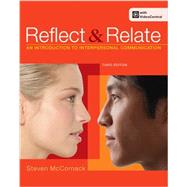In Reflect & Relate, distinguished teacher and scholar Steve McCornack arms students with the best theory and most up-to-date research and then helps them relate that knowledge to their own experiences. The most engaging examples and a lively voice hook students into the research, while features encourage students to critically reflect on their own experiences. Based on years of classroom experience and the feedback of instructors and students alike, every element in Reflect & Relate has been carefully constructed to give students the practical skill to work through life’s many challenges using better interpersonal communication. The new edition is thoroughly revised with new, high interest examples throughout, up-to-the-moment coverage of mediated communication (from internet dating to social media), new chapters on family and friends, integrated video program, and much, much more.
Now with VideoCentral: Interpersonal Communication! This online treasury illustrates key interpersonal terms through short, realistic videos. Featuring over 80 clips, this resource will bring a new media experience to your students’ assignments. Take a tour here.









